Piast dynasty
The Piast dynasty was the first historical ruling dynasty of Poland.[3] The first documented Polish monarch was Duke Mieszko I (c. 930–992).[4] The Piasts' royal rule in Poland ended in 1370 with the death of king Casimir III the Great.
| Piast | |
|---|---|
 | |
| Country | |
| Founded | 960 |
| Founder | semi-legendary Piast the Wheelwright |
| Final ruler | Casimir the Great, in the Kingdom of Poland, and George IV William of Legnica, in the Silesian duchies |
| Titles |
|
| Dissolution | 1370, in the Kingdom of Poland, and 1675, in the Duchies of Silesia |
| Cadet branches |
|
Branches of the Piast dynasty continued to rule in the Duchy of Masovia and in the Duchies of Silesia until the last male Silesian Piast died in 1675. The Piasts intermarried with several noble lines of Europe, and possessed numerous titles, some within the Holy Roman Empire. The Jagiellonian kings after John I Albert were also descended in the female line from Casimir III's daughter.
Origin of the name
The early dukes and kings of Poland are said to have regarded themselves as descendants of the semi-legendary Piast the Wheelwright (Piast Kołodziej),[5] first mentioned in the Cronicae et gesta ducum sive principum Polonorum (Chronicles and deeds of the dukes or princes of the Poles), written c. 1113 by Gallus Anonymus. However, the term "Piast Dynasty" was not applied until the 17th century.[6][7] In a historical work the expression Piast dynasty was introduced by the Polish historian Adam Naruszewicz, it is not documented in contemporary sources.
History
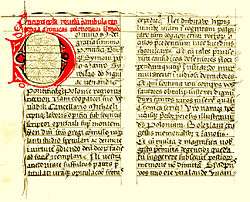
The first "Piasts", probably of Polan descent, appeared around 940 in the territory of Greater Poland at the stronghold of Giecz.[8] Shortly afterwards they relocated their residence to Gniezno, where Prince Mieszko I ruled over the Civitas Schinesghe from about 960. The name Polani, from Slavic: pole ("field"), did not appear until 1015. The Piasts temporarily also ruled over Pomerania, Bohemia and the Lusatias, as well as Ruthenia, and the Hungarian Spiš region in present-day Slovakia. The ruler bore the title of a duke or a king, depending on their position of power.
The Polish monarchy had to deal with the expansionist policies of the Holy Roman Empire in the west, resulting in a chequered co-existence, with Piast rulers like Mieszko I, Casimir I the Restorer or Władysław I Herman trying to protect the Polish state by treaties, oath of allegiances and marriage alliances with the Imperial Ottonian and Salian dynasties. The Bohemian Přemyslid dynasty, the Hungarian Arpads and their Anjou successors, the Kievan Rus', later also the State of the Teutonic Order and the Grand Duchy of Lithuania were mighty neighbours.
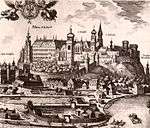
The Piast position was decisively enfeebled by an era of fragmentation following the 1138 Testament of Bolesław III Wrymouth. For nearly 150 years, the Polish state shattered into several duchies, with the Piast duke against the formally valid principle of agnatic seniority fighting for the throne at Kraków, the capital of the Lesser Polish Seniorate Province. Numerous dukes like Mieszko III the Old, Władysław III Spindleshanks or Leszek I the White were crowned, only to be overthrown shortly afterwards. The senior branch of the Silesian Piasts, descendants of Bolesław III Wrymouth's eldest son Duke Władysław II the Exile, went separate ways and since the 14th century were vassals of the Bohemian Crown.
After the Polish royal line and Piast junior branch had died out in 1370, the Polish crown fell to the Anjou king Louis I of Hungary, son of late King Casimir's sister Elizabeth Piast. The Masovian branch of the Piasts became extinct with the death of Duke Janusz III in 1526. The last ruling duke of the Silesian Piasts was George William of Legnica who died in 1675. His uncle Count August of Legnica, the last male Piast, died in 1679. The last legitimate heir, Duchess Karolina of Legnica-Brieg died in 1707 and is buried in Trzebnica Abbey. Nevertheless, numerous families, like the illegitimate descendants of the Silesian duke Adam Wenceslaus of Cieszyn (1574–1617), link their genealogy to the dynasty.
Coat of arms
About 1295, Przemysł II used a coat of arms with a white eagle[9] – a symbol later referred to as the Piast coat of arms or as the Piast Eagle.[10] The Silesian Piasts in the 14th century used an eagle modified by a crescent, which became the coat of arms of the Duchy of Silesia.
Piast rulers
Piast kings and rulers of Poland appear in list form in the following table. For a list of all rulers, see List of Polish monarchs.
Dukes of the Polans
| Name | Lifespan | Reign start | Reign end | Notes | Family | Image |
|---|---|---|---|---|---|---|
Chościsko
| 9th century | 9th century | 9th century | A legendary ruler of the Polans, father of Piast the Wheelwright | Polans (Tribe) |  |
Piast the Wheelwright
| 9th century | 9th century | 9th century | A legendary ruler of the Polans Son of Chościsko, father of Siemowit Founder of the Piast dynasty | Piast | |
Siemowit
| 9th century | 9th century | 9th century | A semi-legendary ruler of the Polans, son of Piast the Wheelwright and Rzepicha | Piast | |
Lestek
| 9th / 10th centuries | 9th / 10th centuries | 9th / 10th centuries | A semi-legendary ruler of the Polans, son of Siemowit | Piast | |
Siemomysł
| 10th century | 10th century | 10th century | A semi-legendary ruler of the Polans, son of Lestek | Piast |
Dukes and Kings of Poland
| Name | Lifespan | Reign start | Reign end | Notes | Family | Image |
|---|---|---|---|---|---|---|
Mieszko I of Poland
| ca. 940 – 25 May 992 | ca. 960 | 992 | Son of Siemomysł First Christian monarch Misico, dux Wandalorum | Piast | 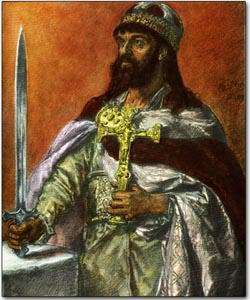 |
Bolesław I the Brave
| 967 – 17 June 1025 | Duke: 992 King: 18 April 1025 | Duke: 18 April 1025 King: 17 June 1025 | Son of Mieszko I and Dobrawa of Bohemia First to be crowned King Regnum Sclavorum, Gothorum sive Polonorum | Piast | 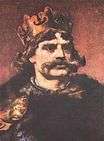 |
Mieszko II Lambert
| ca. 990 – 10/11 May 1034 | 1025 | 1031 | Son of Bolesław I and Emnilda of Lusatia | Piast |  |
Bezprym
| ca. 986 – 1032 | 1031 | 1032 | Son of Bolesław I and Judith of Hungary (disputed) | Piast |  |
Otto Bolesławowic
| 1000 – 1033 | 1032 | 1032 | Son of Bolesław I and Emnilda | Piast |  |
Theodorick
| after 992 - after 1032 | 1032 | 1032 /1033 | Grandson of Mieszko I and Oda of Haldensleben | Piast |  |
Mieszko II Lambert
| ca. 990 – 10/11 May 1034 | 1032 | 1034 | Restored | Piast |  |
Bolesław the Forgotten
| before 1016 – 1038 or 1039 | 1034 | 1038 /1039 | Semi-legendary, existence disputed | Piast |  |
Casimir I the Restorer
| 25 June 1016 – 28 November 1058 (aged 42) | 1039 | 1058 | Son of Mieszko II and Richeza of Lotharingia | Piast |  |
Bolesław II the Bold
| ca. 1041 or 1042 – 2 or 3 April 1081 or 1082 | Duke: 1058 King: 1076 | Duke: 1076 King: 1079 | Son of Kazimierz I and Maria Dobroniega of Kiev | Piast | |
Władysław I Herman
| ca. 1044 – 4 June 1102 | 1079 | 1102 | Son of Kazimierz I and Maria Dobroniega | Piast |  |
Zbigniew
| ca. 1073 – 8 July 1113 | 1102 | 1107 | Son of Władysław I and Przecława of Prawdzic coat of arms (disputed) First jointly with Władysław I 1098-1102 | Piast | |
Bolesław III Wrymouth
| 20 August 1086 – 28 October 1138 (aged 52) | 1107 | 1138 | Son of Władysław I and Judith of Bohemia First jointly with Władysław 1098-1102 Introduced senioral principle | Piast |  |
High Dukes of Poland (Fragmentation of the Kingdom)
| Name | Lifespan | Reign start | Reign end | Notes | Family | Image |
|---|---|---|---|---|---|---|
Władysław II the Exile
| 1105 – 30 May 1159 | 1138 | 1146 | Son of Bolesław III and Zbyslava of Kiev Also Duke of Silesia Exiled by his brothers | Piast |  |
Bolesław IV the Curly
| ca. 1125 – 5 January 1173 | 1146 | 1173 | Son of Bolesław III and Salomea of Berg Also Duke of Masovia | Piast |  |
Mieszko III the Old
| ca. 1127 – 13 March 1202 | 1173 | 1177 | Son of Bolesław III and Salomea Also Duke of Greater Poland | Piast | 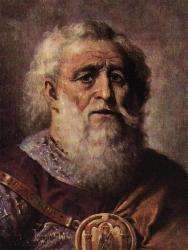 |
Casimir II the Just
| ca. 1138 – 5 May 1194 | 1177 | 1190 | Son of Bolesław III and Salomea Also Duke of Wiślica and Sandomierz | Piast |  |
Mieszko III the Old
| ca. 1127 – 13 March 1202 | 1190 | 1190 | Restored | Piast |  |
Casimir II the Just
| ca. 1138 – 5 May 1194 | 1190 | 1194 | Restored | Piast |  |
Leszek I the White
| ca. 1186 – 24 November 1227 | 1194 | 1198 | Son of Casimir II and Helen of Znojmo Also Duke of Sandomierz | Piast |  |
Mieszko III the Old
| ca. 1127 – 13 March 1202 | 1198 | 1199 | Restored | Piast |  |
Leszek I the White
| ca. 1186 – 24 November 1227 | 1199 | 1199 | Restored | Piast |  |
Mieszko III the Old
| ca. 1127 – 13 March 1202 | 1199 | 1202 | Restored | Piast |  |
Władysław III Spindleshanks
| ca. 1161/66 – 3 November 1231 | 1202 | 1202 | Son of Mieszko III and Eudoxia of Kiev Also Duke of Greater Poland | Piast | 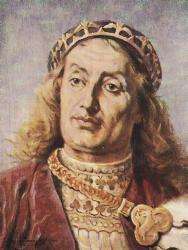 |
Leszek I the White
| ca. 1186 – 24 November 1227 | 1202 | 1210 | Restored | Piast |  |
Mieszko IV Tanglefoot
| ca. 1130 – 16 May 1211 | 1210 | 1211 | Son of Władysław II and Agnes of Babenberg Also Duke of Silesia | Piast | |
Leszek I the White
| ca. 1186 – 24 November 1227 | 1211 | 1225 | Restored | Piast |  |
Henryk I the Bearded
| ca. 1165 – 19 March 1238 | 1225 | 1225 | Grandson of Władysław II, son of Bolesław I the Tall and Krystyna Also Duke of Silesia | Piast |  |
Leszek I the White
| ca. 1186 – 24 November 1227 | 1225 | 1227 | Restored Assassinated | Piast |  |
Władysław III Spindleshanks
| ca. 1161/66 – 3 November 1231 | 1227 | 1229 | Restored | Piast |  |
Konrad I of Masovia
| ca. 1187/88 – 31 August 1247 | 1229 | 1232 | Son of Kazimierz II and Helen of Znojmo Also Duke of Masovia | Piast | 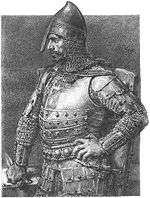 |
Henryk I the Bearded
| ca. 1165 – 19 March 1238 | 1232 | 1238 | Restored | Piast |  |
Henryk II the Pious
| ca. 1196 – 9 April 1241 | 1238 | 1241 | Son of Henry I and Saint Hedwig of Andechs (Saint Hedwig of Silesia) Also Duke of Wroclaw and Greater Poland Fell at Battle of Legnica | Piast | |
Bolesław II Rogatka
| ca. 1220 – 1225 | 1241 | 1241 | Son of Henry II and Anne of Bohemia Also Duke of Silesia | Piast |  |
Konrad I of Masovia
| ca. 1187/88 – 31 August 1247 | 1241 | 1243 | Restored | Piast |  |
Bolesław V the Chaste
| 21 June 1226 – 7 December 1279 | 1243 | 1279 | Son of Leszek the White and Grzymislawa of Luck | Piast |  |
Leszek II the Black
| ca. 1241 – 30 September 1288 | 1279 | 1288 | Paternal grandson of Konrad I of Masovia Maternal grandson of Henry II Son of Casimir I of Kuyavia and Constance of Wrocław | Piast |  |
Bolesław II of Masovia
| ca. 1251 – 20 April 1313 | 1288 | 1288 | Grandson of Konrad I of Masovia Duke of Masovia | Piast |  |
Henryk IV Probus
| ca. 1257/58 – 23 June 1290 | 1288 | 1289 | Paternal grandson of Henryk II Maternal grandson of Konrad I Son of Henry III the White and Judyta of Masovia Duke of Lower Silesia | Piast | |
Bolesław II of Masovia
| ca. 1251 – 20 April 1313 | 1289 | 1289 | Restored | Piast |  |
Władysław I the Elbow-high
| 1261 – 2 March 1333 | 1289 | 1289 | Grandson of Konrad I of Masovia Son of Kazimierz I of Kujawia and Euphrosyne of Opole | Piast | |
Henryk IV Probus
| ca. 1257/58 – 23 June 1290 | 1289 | 1290 | Restored | Piast |
Kings of Poland (Reunification attempts)
| Name | Lifespan | Reign start | Reign end | Notes | Family | Image |
|---|---|---|---|---|---|---|
Przemysł II
| 14 October 1257 – 8 February 1296 (aged 38) | High Duke: 1290 King: 1295 | High Duke: 1291 King: 1296 | Grandson of Henryk II Son of Przemysł I and Elisabeth of Wrocław Also Duke of Poznań, Greater Poland and Pomerania | Piast |
Kings of Poland (Reunited Kingdom)
| Name | Lifespan | Reign start | Reign end | Notes | Family | Image |
|---|---|---|---|---|---|---|
Władysław I the Elbow-high
| 1261 – 2 March 1333 | 1320 | 1333 | Restored Re-united the Kingdom of Poland | Piast | |
Casimir III the Great
| 30 April 1310 – 5 November 1370 (aged 60) | 1333 | 1370 | Son of Władysław I the Elbow-high and Jadwiga of Kalisz Regarded as one of the greatest Polish monarchs | Piast |
Female Piasts
Queen consorts
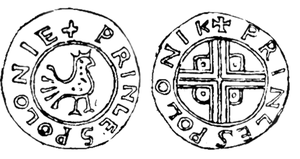
- Świętosława, daughter of Mieszko I of Poland, Queen consort of Denmark, Norway, Sweden and England, mother of Cnut the Great, King of all England, Denmark and Norway
- Świętosława of Poland, daughter of Casimir I the Restorer, Queen consort of Bohemia
- Richeza of Poland, Queen of Sweden, daughter of Bolesław III Wrymouth, Queen consort of Sweden, mother of Canute V of Denmark, King of Denmark and Sophia of Minsk, Queen consort of Denmark
- Richeza of Poland, Queen of Castile, daughter of Władysław II the Exile, Queen consort of León and Galicia, Queen consort of Castile, Empress of All Spains
- Salomea of Poland, daughter of Leszek I the White, Queen consort of Halych
- Fenenna of Kuyavia, daughter of Ziemomysł of Kuyavia, Queen consort of Hungary
- Elizabeth Richeza of Poland, daughter of Przemysł II, Queen consort of Poland and Bohemia
- Viola of Cieszyn, daughter of Mieszko I, Duke of Cieszyn, Queen consort of Hungary, Bohemia and Poland
- Maria of Bytom, daughter of Casimir of Bytom, Queen consort of Hungary
- Beatrice of Silesia, daughter of Bolko I the Strict, Queen of the Romans
- Hedwig of Kalisz, daughter of Bolesław the Pious, Queen consort of Poland, mother of Casimir III the Great King of Poland and Elizabeth of Poland Queen consort of Hungary
- Elizabeth of Poland, daughter of Władysław I the Elbow-high, Queen consort of Hungary, mother of Louis I, King of Poland, Hungary and Croatia and Charles I of Hungary, King of Hungary and Croatia
- Anna of Świdnica, daughter of Henry II, Duke of Świdnica, Queen consort of Germany, of Bohemia and Holy Roman Empress, mother of Wenceslaus IV of Bohemia, King of the Romans and of Bohemia
- Hedwig of Sagan, daughter of Henry V of Iron, Queen consort of Poland
Priesthood
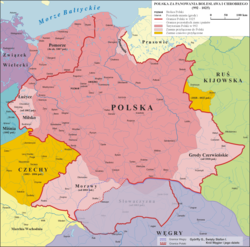
Archbishops
- Bolesław of Toszek – Archbishop of Esztergom
- Władysław of Wroclaw – Archbishop of Salzburg
Bishops
- Jarosław of Opole – Bishop of Wrocław
- Mieszko of Bytom – Bishop of Nitra and of Veszprém
- Henry of Masovia – Bishop of Płock
- Jan Kropidło – Bishop of Poznań, Włocławek, Kamień and Chełmno, Archbishop of Gniezno (only formally)
- Wenceslaus II of Legnica – Bishop of Lebus and of Wrocław
- Henry VIII of Legnica – Bishop of Wrocław
- Konrad IV the Older – Bishop of Wrocław
- Alexander of Masovia – Bishop of Trento
- Casimir III of Płock – Bishop of Płock
Family tree of Piasts
| Chościsko | |||||||||||||||||||||||||||||||||||||||||||||||||||||||||||||||||||||||||||||||||||||||||||||||||||||||||||||
| Piast the Wheelwright HOUSE OF PIAST | |||||||||||||||||||||||||||||||||||||||||||||||||||||||||||||||||||||||||||||||||||||||||||||||||||||||||||||
| Siemowit duke of Polans | |||||||||||||||||||||||||||||||||||||||||||||||||||||||||||||||||||||||||||||||||||||||||||||||||||||||||||||
| Lestek duke of Polans | |||||||||||||||||||||||||||||||||||||||||||||||||||||||||||||||||||||||||||||||||||||||||||||||||||||||||||||
| Siemomysł duke of Polans | |||||||||||||||||||||||||||||||||||||||||||||||||||||||||||||||||||||||||||||||||||||||||||||||||||||||||||||
| Mieszko I of Poland duke of Poland | Czcibor prince | ||||||||||||||||||||||||||||||||||||||||||||||||||||||||||||||||||||||||||||||||||||||||||||||||||||||||||||
Bolesław I the Brave king of Poland | Vladivoj duke of Bohemia | Mieszko I prince | Świętopełk prince | Lambert prince | |||||||||||||||||||||||||||||||||||||||||||||||||||||||||||||||||||||||||||||||||||||||||||||||||||||||||
| Bezprym duke of Poland | Mieszko II Lambert king of Poland | Otto prince | Dytryk prince | ||||||||||||||||||||||||||||||||||||||||||||||||||||||||||||||||||||||||||||||||||||||||||||||||||||||||||
| Bolesław the Forgotten duke of Poland | Casimir I the Restorer duke of Poland | ||||||||||||||||||||||||||||||||||||||||||||||||||||||||||||||||||||||||||||||||||||||||||||||||||||||||||||
Bolesław II the Generous king of Poland | Władysław I Herman duke of Poland | Mieszko prince | |||||||||||||||||||||||||||||||||||||||||||||||||||||||||||||||||||||||||||||||||||||||||||||||||||||||||||
| Mieszko prince of Cracow | Zbigniew prince | Bolesław III Wrymouth duke of Poland | |||||||||||||||||||||||||||||||||||||||||||||||||||||||||||||||||||||||||||||||||||||||||||||||||||||||||||
| Władysław II the Exile duke of Silesia BRANCH OF SILESIA | Bolesław IV the Curly high duke of Poland | Mieszko III the Old duke of Greater Poland BRANCH OF GREATER POLAND | Henry duke of Sandomierz | Casimir II the Just duke of Masovia BRANCH OF LESSER POLAND | |||||||||||||||||||||||||||||||||||||||||||||||||||||||||||||||||||||||||||||||||||||||||||||||||||||||||
| Leszek duke of Masovia | Odon duke of Greater Poland | Stephen prince | Mieszko the Younger duke of Kalisz | Władysław III Spindleshanks duke of Greater Poland | Leszek the White duke of Sandomierz | Konrad I duke of Masovia | |||||||||||||||||||||||||||||||||||||||||||||||||||||||||||||||||||||||||||||||||||||||||||||||||||||||
| Władysław duke of Greater Poland | Bolesław V the Chaste duke of Sandomierz | Bolesław I duke of Masovia | Casimir I duke of Kuyavia | Siemowit I duke of Masovia BRANCH OF MASOVIA | |||||||||||||||||||||||||||||||||||||||||||||||||||||||||||||||||||||||||||||||||||||||||||||||||||||||||
| Przemysl I duke of Greater Poland | Bolesław the Pious duke of Greater Poland | Leszek II the Black duke of Sieradz | Ziemomysł duke of Inowrocław | Władysław I the Elbow-high king of Poland | Casimir II duke of Łęczyca | Siemowit duke of Dobrzyń | Konrad II duke of Masovia | Bolesław II duke of Masovia | |||||||||||||||||||||||||||||||||||||||||||||||||||||||||||||||||||||||||||||||||||||||||||||||||||||
Przemysł II king of Poland | Leszek duke of Inowrocław | Przemysł duke of Inowrocław | Kazimierz III duke of Inowrocław | Casimir III the Great king of Poland | Leszek duke of Dobrzyń | Władysław the Hunchback duke of Dobrzyń | Bolesław duke of Dobrzyń | Siemowit II duke of Warsaw | Trojden I duke of East Masovia | Wenceslaus duke of Plock | |||||||||||||||||||||||||||||||||||||||||||||||||||||||||||||||||||||||||||||||||||||||||||||||||||
| Anna of Poland ∞ William, Count of Celje | Bolesław-Jerzy II king of Galicia-Volhynia | Siemowit III, Duke of Masovia duke of Masovia | Casimir I duke of Warsaw | ||||||||||||||||||||||||||||||||||||||||||||||||||||||||||||||||||||||||||||||||||||||||||||||||||||||||||
| Anna of Cilli ∞ Władysław II Jagiełło king of Poland | Janusz I duke of Warsaw | Siemowit IV duke of Plock BRANCH OF PLOCK | Henry bishop of Plock | ||||||||||||||||||||||||||||||||||||||||||||||||||||||||||||||||||||||||||||||||||||||||||||||||||||||||||
| Janusz the Younger heir | Bolesław heir | Konrad Januszowic prince | Siemovit V duke of Plock | Alexander bishop of Trento | Casimir III duke of Plock | Trojden II duke of Plock | Wladysław I duke of Plock | ||||||||||||||||||||||||||||||||||||||||||||||||||||||||||||||||||||||||||||||||||||||||||||||||||||||
| Boleslaw IV duke of Warsaw | Siemovit VI duke of Plock | Wladysław II duke of Plock | |||||||||||||||||||||||||||||||||||||||||||||||||||||||||||||||||||||||||||||||||||||||||||||||||||||||||||
| Konrad III Rudy duke of Warsaw | Casimir IIi bishop of Plock | Bolesław V duke of Plock | Janusz II duke of Plock | ||||||||||||||||||||||||||||||||||||||||||||||||||||||||||||||||||||||||||||||||||||||||||||||||||||||||||
| Stanislav duke of Warsaw | Janus III duke of Warsaw | ||||||||||||||||||||||||||||||||||||||||||||||||||||||||||||||||||||||||||||||||||||||||||||||||||||||||||||
See also
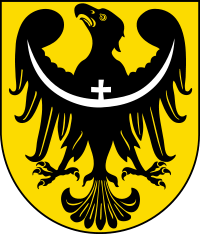
- Kings of Poland family tree
- List of Polish rulers
- Dukes of Silesia
- Silesian Piasts
- Dukes of Masovia
- Dukes of Greater Poland
- Dukes of Teschen
- Dukes of Leczyca
- Dukes of Sieradz
- Category:House of Piast
- Wawel Castle
- Kingdom of Galicia–Volhynia
- Duchy of Bohemia
- King of Poland
- King of Rus'
- Duke of the Polans
- Duke of Poland
- Duke of Krakow
- Duke of Kuyavia
- Duke of Sandomierz
- Duke of Sieradz-Łęczyca
- Duke of Bohemia
References
- A. Małecki, Studya heraldyczne [Heraldic Studies], vol. I, Lwów 1890, pp. 268-285; M. L. Wójcik, Ród Gryfitów do końca XIII wieku. Pochodzenie — genealogia — rozsiedlenie, Historia CVII, Wrocław 1993, p. 39.
- Rodowód książąt pomorskich Edward Rymar Książnica Pomorska, 2005, page 53
- "FamilyTreeDNA - Genetic Testing for Ancestry, Family History & Genealogy". www.familytreedna.com. Retrieved 22 June 2019.
- Ring, Trudy; Watson, Noelle; Schellinger, Paul (28 October 2013). Northern Europe: International Dictionary of Historic Places. Routledge. ISBN 9781136639517. Retrieved 22 June 2019 – via Google Books.
- Ulwencreutz, Lars (1 November 2013). Ulwencreutz's The Royal Families in Europe V. Lulu.com. ISBN 9781304581358. Retrieved 22 June 2019 – via Google Books.
- Encyklopedia Powszechna PWN Warsaw 1975 vol. III p. 505
- "Piast Dynasty". Encyclopædia Britannica. Retrieved 30 March 2011.
The name Piast was not applied to the dynasty until the 17th century.
- "Gniezno czy Giecz, czyli skąd pochodzi dynastia?". Gniezno czy Giecz, czyli skąd pochodzi dynastia? - Gniezno czy Giecz, czyli skąd pochodzi dynastia? - Wydarzenia - Wiedza - HISTORIA: POSZUKAJ. Retrieved 22 June 2019.
- Tomaney, William. "Poland Today » White eagle regains its crown". Poland Today » White eagle regains its crown. Retrieved 9 May 2019.
- Górczyk, Wojciech, "Półksiężyc, orzeł, lew i smok. Uwagi o godłach napieczętnych Piastów" http://histmag.org/?id=3057&act=ac
